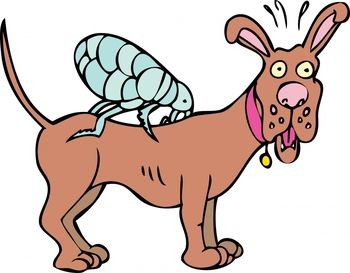
It’s September. Beware! This is the peak month for fleas in Connecticut. Not too hot, not too cold. Just right. It can go on right up to the first hard frost and the start of the home heating season.
Read more about the following products by clicking on their highlighted names.
Hopefully you haven’t suffered any issues with your dog or cat. Dogs who go outside every day (most do, right?) need to be on a flea and tick preventative. We are particularly fond of NexGard as it is chewable and works great against both fleas and ticks. There are still a number of topical, spot on products on the market, but honestly they are losing their appeal. They’re definitely messier to use, not nearly as effective and the cost differential from the oral products is small.
For cats, even if they don’t go outside, beware. If you have a dog too, they can bring fleas into your house and transmit them to your cats. It’s possible for fleas to hitch a ride on you or a family member if you visit someone else who has a flea problem in their house. They can latch onto your clothing and just go home for the ride. So don’t be so sure that your cat is immune just because he or she is an isolated house pet. Frontline is our preferred product for cats because it also is effective against ticks. Revolution works well against fleas as well as preventing heartworm disease in cats, which is rare. A product called Cheristin is probably the best at killing fleas on cats. We use all of them.
I also recommend pet owners be aware of the flea life cycle. It’s like a butterfly or moth life cycle; egg, larva. pupa (cocoon) and adult flea. If you have a flea problem over 95% of your fleas will be eggs, larva and pupa. They don’t bite. You don’t see them….and…mostly they are NOT on your pet. They are in the pet’s bedding, your carpeting or upholstery. Oh yes…yes they are.
To get rid of them you will not only need to get them off your pet, but out of the house as well. Some people use foggers that can be picked up wherever pet supplies are sold. If you do get several small ones…not the big cans. One small fogger per room. We highly recommend using a spray. They’re safer, can be put directly where your pet spends the most time and you do not have to vacate the premises when you use it. The important thing about the sprays and foggers is that they need to contain Methoprene. This is not an insecticide, but rather a synthetic growth regulator that stops the flea reproductive life cycle in it’s tracks. It’s harmless to people and pets, but devastating to fleas. It keeps the eggs and larvae from becoming a pupa. Siphotrol Premise Spray is our recommended product.
Often, particularly dogs, will develop hot spots and severe pyoderma from fleas. Medicated shampoos and antibiotics are often needed. We are increasingly using a new anti-allergy product from Zoetis (formerly part of Pfizer) called Apoquel that controls the severe itchiness of flea bite dermatitis without the nuisance side effects that steroids can cause; like excessive thirst and urinating. It’s really effective. We like it a lot.
In the end fleas like an environment when the temperature is around 70 degrees and the humidity is 70% and above. Sounds like Connecticut in September.


